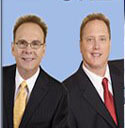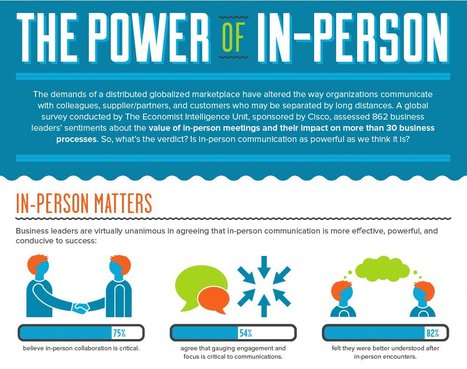 Your new post is loading...
 Your new post is loading...
From your head to your toes, how to code and decode unconscious cues. . .
Virtual collaboration comes with its own unique challenges -- especially for leaders whose previous experience has been mainly with collocated teams. . .
When you are planning a meeting with people from different cultures, maybe you have already prepared by learning about the way people greet each other and other surface cultural differences. But chances are that your meeting might be derailed by some non-obvious cultural misunderstandings. Here are the top three problems I have seen during workshops and coaching people about intercultural business. . .
Via Ann Marie Lei
People are always smiling, especially in groups, but it doesn't just signal that they're happy, far from it. We use smiles for specific social purposes because they can send out all sorts of signals that can be useful for us.
Here are ten ways smiles can be used to our advantage by sending out messages about our trustworthiness, attractivity, sociability, and more. . .
We like to believe that a few bad apples spoil the virtuous bunch. But research shows that everyone cheats a little—right up to the point where they lose their sense of integrity, writes Dan Ariely. . .
After extensive studies, the MIT Media Lab concluded that it could predict the outcome of negotiations, telephone sales calls, and business plan pitches with 87 percent accuracy simply by analyzing participants’ body language, without listening to a single word of content. . .
Negotiating is an essential skill.
Understand the seven pillars of effective influence. A good portion of being a good negotiator is just being a good person.
Believe that you can improve your negotiating skills and you can. . .
Being able to hold a meeting when the attendees are scattered all over the globe has changed the face of business. You can take on international clients or choose manufacturers in other countries with relative ease.
You don’t even need to calculate the long-distance charges anymore: with cloud-based software, holding a meeting, even when you need to share large files, can be free. . .
Consumers on hold with a customer servicerepresentative hang up after reaching a "boiling point" . . . according to a recent survey.
Then, they're likely to ditch that company for another one. . . .
Negotiating is tough.
But if you want to make it to the top, you must learn how to do it effectively, says career expert and author Selena Rezvani, whose latest book is Pushback: How Smart Women Ask — and Stand Up — for What They Want. . .
There is much more to conducting a successful meeting than simply preparing an agenda, issuing invitations to those you want to attend and make a contribution, and turning up on the day.
A successful meeting requires effective planning, and a key element in that planning, is organising the logistics that provide the framework in which a successful meeting can be conducted. This good article, explains the importance of the logistical element of any meeting, and it offers tips on what needs to be planned for each of the four phases of any meeting, to ensure overall meeting success. . .
Via Daniel Watson
FAST COMPANY: So what is the myth of charisma and where did it come from?
OLIVIA FOX CABANE: It came from the Greeks, who coined the word as “gift of grace.” They believed it was a divine gift. The myth is that charisma is not innate. What scientists have actually discovered--like many other myths they busted this one--is it’s actually a social skill, which like many others is learned. But this happens so early in life that by the time these charismatics get to adulthood, it all seems to be natural. . .
|
The standard view of cost-benefit reasons for lying is flawed, says behavioral economist Dan Ariely in his new book, The (Honest) Truth About Dishonesty.
"People don't really decide to cheat on what they stand to gain or lose. As long as cheaters can rationalize their fraudulent actions and still think of themselves as good people, they would lie," says Ariely. . .
People say a lot of things that aren't true.Most body langauge is contextual and can be misinterpreted.
What signals can and should you trust when trying to get a "read" on someone? They need to be unconscious behaviors that are not easily controlled and convey a clear message. . .
Meetings are a great opportunity to present your ideas and become engaged in the decision-making process. Meetings often involve open-ended discussion among different types of people.
For this reason, there is no easy formula that will guarantee success. Instead, you need to develop a range of skills and techniques that will help you express your ideas clearly and tactfully. . .
Do actions really speak louder than words? Ray Birdwhistell, a pioneer investigator into the world of body language, found that the verbal component of a face-to-face conversation is 35 percent verbal, while 65 percent of the message is communicated nonverbally. Meaning the bulk of the impact of your words is not what you say, it’s how you say it. . .
As a business owner or business manager, most of the meetings you call will be to help you drive your own agenda for the business, and you need to ensure that these meetings are as effective as possible in terms of time consumes and outcomes achieved. The better you become at creating great meetings, the more receptive your employees will be to becoming active participants, and the higher the level of their commitment to achieving the required outcomes. This excellent article, discusses the correct order for your agenda items, and then it offers 8 tips that you can follow to create your own great meetings. . .
Via Daniel Watson
One of my most popular interactive presentations is called “Who’s Telling Your Story?” It outlines a clear strategy to enlist and inspire a deeply active community of fiercely loyal fans who spread your story and protect your brand.
The first key point in that presentation is to know your story and to build your network before you need it.
But not all networks are equal. The network that builds a business, a brand and a reputation is connected by deep trust and consistent behavior. . .
Excellent teams don't just come together by accident. It takes a lot of hard work to create synergy. . .
When it comes to meetings, co-workers can be deadly. Among the biggest offenders are naysayers and co-workers who wander off-topic.
To boost productivity, some managers take extreme measures. . .
According to a Pew Research study, Internet users appear to be more active in social groups than non-Internet users. . .
If you have been in the professional world for more than a year, you have probably heard something like this a million times:
“My leadership philosophy is to optimally leverage the passions of my people such that at the end of the day we maximize employee engagement to get them to think outside the box and synergistically drive value-added activities in a profit-maximizing way that is a win-win for our people, our shareholders, and our customers.”
It sounds great. It is polysyllabic. It uses words with long definitions. I have only one question: what the heck does it mean? . . .
Keeping employees in the dark is the most common management mistake, according to a new poll.
A survey by staffing firm Accountemps shows that 41 percent of chief financial officers believe a lack of communication between staff and management is the most frequent misstep companies make in managing their employees. . .
|




 Your new post is loading...
Your new post is loading...
































